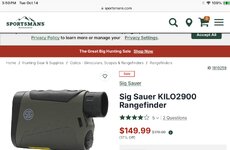Coopsdaddy
WKR
I have finally got my rifles put together and ready to learn some longer distance shooting.
My goal is to be a better hunter at a reasonable distance (600)for hunting and would like to practice futher as much as possible.
Shot many whitetails over the years out to 200 and a bunch more with archery but this is something I’ve wanted to learn for awhile.
I will shoot off a table some but my focus is hunting situations so most of the stuff I buy needs to be used in my hunting.
Barrett fieldcrafts in 6.5 and 30/06
Tbac ultra 7
Nightforce NXS 2.5-10x42 mil
I have basic selection of small bags thanks to hereinaz,Tricer bipod,Aziak ridgeline tripod.
8x32 Zeiss binos,exo k4 pack
I don't reload.
I want to learn the process and the math to using this mil scope and dialing as well as body position etc.
I have bookmarked forms post on using a mil scope and used it this week to sight it.Fantastic information!
Im going to look into taking a class in 2026.
Need advice on range finder,bino/spotter,apps and other gear.
I'm not a tech guy or loaded so I will probably buy my binos/spotter used but may buy the range finder new during Black Friday.
Prefer the simplest setup as far as gear and apps go.
Prefer stand alone binos.
Not sure about spotting scope or larger binos.Ill never be sheep hunting but elk,bear will on the menu.
Im looking at the Revic br4 but prefer advise before I buy.
Do I need a chronograph?
My goal is to be a better hunter at a reasonable distance (600)for hunting and would like to practice futher as much as possible.
Shot many whitetails over the years out to 200 and a bunch more with archery but this is something I’ve wanted to learn for awhile.
I will shoot off a table some but my focus is hunting situations so most of the stuff I buy needs to be used in my hunting.
Barrett fieldcrafts in 6.5 and 30/06
Tbac ultra 7
Nightforce NXS 2.5-10x42 mil
I have basic selection of small bags thanks to hereinaz,Tricer bipod,Aziak ridgeline tripod.
8x32 Zeiss binos,exo k4 pack
I don't reload.
I want to learn the process and the math to using this mil scope and dialing as well as body position etc.
I have bookmarked forms post on using a mil scope and used it this week to sight it.Fantastic information!
Im going to look into taking a class in 2026.
Need advice on range finder,bino/spotter,apps and other gear.
I'm not a tech guy or loaded so I will probably buy my binos/spotter used but may buy the range finder new during Black Friday.
Prefer the simplest setup as far as gear and apps go.
Prefer stand alone binos.
Not sure about spotting scope or larger binos.Ill never be sheep hunting but elk,bear will on the menu.
Im looking at the Revic br4 but prefer advise before I buy.
Do I need a chronograph?

